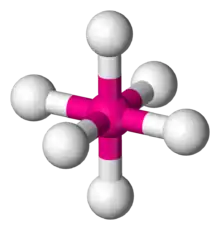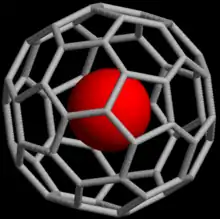Double group
The concept of a double group was introduced by Hans Bethe for the quantitative treatment of magnetochemistry of complexes of ions like Ti3+, that have a single unpaired electron in the metal ion's valence electron shell and to complexes of ions like Cu2+ which have a single "vacancy" in the valence shell.[1][2]
In the specific instances of complexes of metal ions that have the electronic configurations 3d1, 3d9, 4f1 and 4f13, rotation by 360° must be treated as a symmetry operation R, in a separate class from the identity operation E. This arises from the nature of the wave function for electron spin. A double group is formed by combining a molecular point group with the group {E, R} that has two symmetry operations, identity and rotation by 360°. The double group has twice the number of symmetry operations compared to the molecular point group.
Background
In magnetochemistry, the need for a double group arises in a very particular circumstance, namely, in the treatment of the paramagnetism of complexes of a metal ion in whose electronic structure there is a single electron (or its equivalent, a single vacancy) in a metal ion's d- or f- shell. This occurs, for example, with the elements copper and silver in the +2 oxidation state, where there is a single vacancy in a d-electron shell, with titanium(III) which has a single electron in the 3d shell and with cerium(III) which has a single electron in the 4f shell.
In group theory, the character , for rotation of a molecular wavefunction for angular momentum by an angle α is given by
where ; angular momentum is the vector sum of orbital and spin angular momentum. This formula applies with most paramagnetic chemical compounds of transition metals and lanthanides. However, in a complex containing an atom with a single electron in the valence shell, the character, , for a rotation through an angle of about an axis through that atom is equal to minus the character for a rotation through an angle of [3]
The change of sign cannot be true for an identity operation in any point group. Therefore, a double group, in which rotation by , is classified as being distinct from the identity operation, is used. A character table for the double group D'4 is as follows. The new symmetry operations are shown in the second row of the table.
Character table: double group D'4 D'4 E C4 C43 C2 2C'2 2C''2 R C4R C43R C2R 2C'2R 2C''2R A'1 1 1 1 1 1 1 1 A'2 1 1 1 1 1 -1 -1 B'1 1 1 -1 -1 1 1 -1 B'2 1 1 -1 -1 1 -1 1 E'1 2 -2 0 0 -2 0 0 E'2 2 -2 √2 -√2 0 0 0 E'3 2 -2 -√2 √2 0 0 0
The symmetry operations such as C4 and C4R belong to the same class but the column header is shown, for convenience, in two rows, rather than C4, C4R in a single row .
Character tables for the double groups T', O', Td', D3h', C6v', D6', D2d', C4v', D4', C3v', D3', C2v', D2' and R(3)' are given in Salthouse and Ware.[4]
Applications



The need for a double group occurs, for example, in the treatment of magnetic properties of 6-coordinate complexes of copper(II). The electronic configuration of the central Cu2+ ion can be written as [Ar]3d9. It can be said that there is a single vacancy, or hole, in the copper 3d-electron shell, which can contain up to 10 electrons. The ion [Cu(H2O)6]2+ is a typical example of a compound with this characteristic.
- (1) Six-coordinate complexes of the Cu(II) ion, with the generic formula [CuL6]2+, are subject to the Jahn-Teller effect so that the symmetry is reduced from octahedral (point group Oh) to tetragonal (point group D4h). Since d orbitals are centrosymmetric the related atomic term symbols can be classified in the subgroup D4 .
- (2) To a first approximation spin–orbit coupling can be ignored and the magnetic moment is then predicted to be 1.73 Bohr magnetons, the so-called spin-only value. However, for a more accurate prediction spin–orbit coupling must be taken into consideration. This means that the relevant quantum number is J, where J = L + S.
- (3) When J is half-integer, the character for a rotation by an angle of α + 2π radians is equal to minus the character for rotation by an angle α. This cannot be true for an identity in a point group. Consequently, a group must be used in which rotations by α + 2π are classed as symmetry operations distinct from rotations by an angle α. This group is known as the double group, D4'.
With species such as the square-planar complex of the silver(II) ion [AgF4]2- the relevant double group is also D4'; deviations from the spin-only value are greater as the magnitude of spin–orbit coupling is greater for silver(II) than for copper(II).[5]
A double group is also used for some compounds of titanium in the +3 oxidation state. Titanium(III) has a single electron in the 3d shell; the magnetic moments of its complexes have been found to lie in the range 1.63 - 1.81 B.M. at room temperature.[6] The double group O' is used to classify their electronic states.
The cerium(III) ion, Ce3+, has a single electron in the 4f shell. The magnetic properties of octahedral complexes of this ion are treated using the double group O'.
When a cerium(III) ion is encapsulated in a C60 cage, the formula of the endohedral fullerene is written as {Ce3+@C603-}. [7] The magnetic properties of the compound are treated using the icosahedral double group I2h. [8]
Free radicals
Double groups may be used in connection with free radicals. This has been illustrated for the species CH3F+ and CH3BF2+ which both contain a single unpaired electron.[9]
See also
References
- Cotton, F. Albert (1971). Chemical Applications of Group Theory. New York: Wiley. pp. 289–294, 376. ISBN 0-471-17570-6.
- Tsukerblat, Boris S. (2006). Group Theory in Chemistry and Spectroscopy. Mineola, New York: Dover Publications Inc. pp. 245–253. ISBN 0-486-45035-X.
- Lipson, R.H. "Spin-orbit coupling and double groups" (PDF).
- Salthouse, J.A.; Ware, M.J. (1972). Point group character tables and related data. Cambridge: Cambridge University Press. pp. 55–57. ISBN 0-521-081394.
- Foëx, D.; Gorter, C. J.; Smits, L.J. (1957). Constantes Sélectionées Diamagnetism et Paramagnetism. Paris: Masson et Cie.
- Greenwood, Norman N.; Earnshaw, Alan (1997). Chemistry of the Elements (2nd ed.). Butterworth-Heinemann. p. 971. ISBN 978-0-08-037941-8.
- Chai, Yan; Guo, Ting; Jin, Changming; Haufler, Robert E.; Chibante, L. P. Felipe; Fure, Jan; Wang, Lihong; Alford, J. Michael; Smalley, Richard E. (1991). "Fullerenes with metals inside". The Journal of Physical Chemistry. 95 (20): 7564–7568. doi:10.1021/j100173a002.
- Balasubramanian, K. (1996). "Double group of the icosahedral group (Ih) and its application to fullerenes". Chemical Physics Letters. 260 (3): 476–484. Bibcode:1996CPL...260..476B. doi:10.1016/0009-2614(96)00849-4.
- Bunker, P.R. (1979), "The Spin Double Groups of Molecular Symmetry Groups", in Hinze, J. (ed.), The Permutation Group in Physics and Chemistry, Lecture Notes in Chemistry, vol. 12, Springer, pp. 38–56, doi:10.1007/978-3-642-93124-6_4, ISBN 978-3-540-09707-5
Further reading
Earnshaw, Alan (1968). Introduction to Magnetochemistry. Academic Press.
Figgis, Brian N.; Lewis, Jack (1960). "The magnetochemistry of complex compounds". In Lewis, J.; Wilkins, R.G. (eds.). Modern Coordination Chemistry. New York: Interscience. pp. 400–451.
Orchard, Anthony F. (2003). Magnetochemistry. Oxford Chemistry Primers. Oxford University Press. ISBN 0-19-879278-6.
Vulfson, Sergey G.; Arshinova, Rose P. (1998). Molecular Magnetochemistry. Taylor & Francis. ISBN 90-5699-535-9.